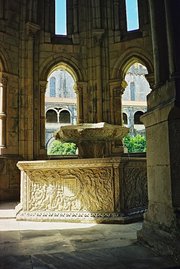|
|
Alcobaça is in the district of Leiria, in Portugal (though formerly included in the province of Estremadura), on the Alcoa and Baca rivers, from which it derives its name.
Alcobaça grew along the valleys of the rivers Alcoa and Baça.
| Contents |
Introduction
A town that only became notable in the 12th Century when it became the site for the important construction of Portugal’s largest church. In the month of March in 1147 the fledgling King, Dom Afonso Henriques, defeated the Moors by capturing the town of Santarém. As a suitable memory to this splendid victory he vowed to build a magnificent home for the Order of Cistercians. It took another 76 years before this task was completed. The monarchy continued to endow the Monastery with further construction and 60 years later King Dinis built the main cloister but it was only in 1252 that the Monastery was inaugurated within the church. In the church are the tombs of King Peter I and his murdered mistress Inês de Castro and with it the story of the tragic liaison between Pedro and his ever-lasting love for Inês. Forced at an early age by royal duty he had to marry Constanza, the Infanta of Castile. She died within a short time of the marriage ceremony and created the opportunity for Dom Pedro to escape with his true love and live in the city of Coimbra. King Afonso IV his father, believing that the family of Inês to be a threat to his own kingdom had her murdered. Shortly after the death of his father Dom Pedro declared that he had married Inês in a prior secret ceremony in Bragança, promptly taking revenge on the killers in a very gruesome manner and exhumed her body. He presented the embalmed corpse at court with a crown on her head and demanded that all his courtiers kneel and individually pay homage to her decomposed hand. Today, their ornate tombs face each other so that on the Judgment Day his first sight would be of his beloved Inês. During the following centuries the monks from this monastery had an influencing effect on Portuguese culture. Notably, in 1269 they were the first to give public lessons to their flock, and later they produced the authoritative history on Portugal in a series of books. In 1810 the invading French pillaged the Abbey taking with them most of the many treasures including a noteworthy library. Whatever the items remaining were then later stolen in 1834 during an anti-clerical riot and the extinction of religious Orders in Portugal.
Description
The main feature of the town is essentially the Abbey that proudly presents a long and sombre façade with 18th Century embellishments. This austerity is further emphasized in the cloisters with its apt name of “Cloister of Silence”. In contrast within the Abbey is the massive kitchen with a running stream specially diverted to pass through as a supply of fresh water. The open area of the kitchen chimney is large enough to take a whole ox for roasting. The surround to the sacristy doorway is an outstanding example of Manueline decoration. In 1794, Lord Beckford visited the Abbey and commented that he found some 300 monks “living in a very splendid manner”!
Nearby locations
A few kilometers to the north of Alcobaça is another wondrous building constructed in memory of a different important battle, that of Aljubarrota in 1385, when Dom João I defeated the Castilians and ensuring two hundred years of independence from the Spanish invaders. The construction of the Abbey at Batalha commenced in 1388 and was added to by various Portuguese Kings over these next two centuries. To the east of Batalha is the world famous location of Fátima and a point of pilgrimage for the Roman Catholic religion due to the vision of the Virgin Mary in 1917 by three young children whilst tending their flock. To the west of Alcobaça is the well-known fishing village of Nazaré. Today, the village is now a small town and a popular holiday resort with most of its past and traditions having rapidly evaporated in the course of time. A very successful Portuguese feature film was made in the early 20th Century that dramatically captured the primitive and dangerous life of these fishermen. Stoutly Catholic, the inhabitants have retained some of their past as can be still seen in their own particular style of costume. To the south is Caldas da Rainha and the quaint medieval town of Óbidos that is an attraction for any tourists that enjoys a true glimpse of the past. Also to the south is the town of Porto de Mós with its fanciful rebuilt castle. This town borders the Nature Reserve Parque Natural das Serras de Aire e Candeeiros. These 390 square kilometres of limestone-covered landscape is also known for its underground caverns. The most well known being the Grutas de Mira de Aire can be visited and consists of tunnels, caverns with stalactites, stalagmites, lakes, and a music and light finale.
Events
Festival de Musica May Feira de São Bernardo 20th August Town holiday 20th August Feira de São Simão 4th week of October Market day: Every Monday
Telephone numbers
Town Hall +351 262 598 174 Fire brigade +351 262 598 598 Police +351 262 595 400 SOS 112 Support to tourists 800 296 296 Railways (CP) - www.cp.pt 808 208 208
Useful facts
Postal code 2460 Altitude 42 m Council inhabitants 85.100 City inhabitants 16.230 Distances Lisbon - 109 km Santarém - 59 kmde:Alcobaça (Portugal) pt:Alcobaça (Portugal) ro:Alcobaça

